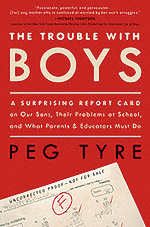
In a third-grade classroom at Wilmette's Central School, IT IS "snack time"—a 15-minute period when Cheez-Its are gobbled, Doritos are munched, and eight- and nine-year-olds happily put their brains on autopilot.
But two boys aren't eating; they're pitching a tennis ball back and forth as they do every day during snack time. A row of windows nearby seems ripe for shattering, but the pals have teacher Kevan Truman's blessing—if an ambivalent one. "At first, the traditional-teacher part of my brain was screaming, 'Warning! I can't have a tennis ball flying through the room!'" Truman says. "But the other part of me said, 'No, see if it can work.'"
Truman wouldn't have pushed his pedagogical comfort zone like this a few years ago. But the way he and others in District 39 teach and interact with boys has recently undergone a profound shift. "Wilmette is a kind of model of how you change hearts and minds in a community," says the New York–based journalist Peg Tyre, who profiles District 39 in her new book, The Trouble with Boys: A Surprising Report Card on Our Sons, Their Problems at School, and What Parents and Educators Must Do (Crown; $24.95), out in September.
Tyre isn't the first writer to raise the red flag for boys. The past decade has coughed up a spate of boys-in-crisis tomes including Raising Cain (1999) and The War Against Boys (2000). Tyre's book argues, convincingly, that boys and girls often need to be taught and treated differently in school, for reasons that run the gamut from brain chemistry to boys' later acquisition of language skills. Yet, despite the growing literature, parents and educators feel "a great unease about discussing this," Tyre says. "People don't want to be perceived as anti-girl."
That was certainly the case in Wilmette. When Dr. Glenn "Max" McGee arrived in 2002 as superintendent, he noticed that the district's girls were scoring better than boys in reading and writing on standardized tests—a troubling gender gap he'd seen statewide when he was Illinois state superintendent of schools. In the fall of 2005, McGee asked a high-powered committee of 25 Wilmette parents, teachers, and administrators to study the gap. It was a gap some of them denied existed.
"There was a flabbergasting amount of resistance," recalls Diane Fischer, a parent on the committee. "People didn't think it was a problem and didn't want undue emphasis put on boys' and girls' differences. They thought we were having a 1950s mindset—that boys like trucks and girls like dolls."
Only eight committee members agreed to look into the matter. After a four-month review of items such as grades, test scores, and teacher attitudes, they produced a more than 100-page report showing that while there was no difference in intelligence between Wilmette's boys and girls, the boys trailed girls by almost every academic measure. Specifically:
- In grades 5 through 8, girls had higher grades across all four core subjects: reading, writing, science, and math.
- Boys were more likely to get grades of C or lower, and girls were 30 to 35 percent more likely to receive an A.
- For the previous four years at every level of junior high school math, girls outperformed boys.
 |
Tyre's book details how a handful of teachers formed a study group and came up with solutions. Most took aim at subtle dynamics in the classroom that cause boys to disengage and tried to get them hooked back into school. Third-grade teacher Truman began offering more boy-friendly choices in his assignments. In a lesson about a certain fairy tale, he'd assigned students in the past to illustrate the ballroom scene. Last year, he added the option of drawing the story's medieval castle—which appealed more to a group of boys he calls "my maker-builder-doers."
In response to research that boys learn better when they're able to move around more, fourth-grade teacher Traci Meziere structured work in the classroom so that every 15 to 20 minutes all her kids could get up and move. She also became more relaxed about noise.
"I realized how much I had imposed a noise standard that was comfortable to me," she says, "but maybe not for the boys."
These are desperately needed measures, according to Fischer, the parent on the study committee. An Evanston-based psychologist who sees teens in her practice, she says: "By the time boys are in high school, many are quite disengaged from school. They're good, bright kids, from high-achieving families, and they'll go to school with their homework and don't even bother handing it in. I can't tell you how many mothers I've heard that from. Their parents are desperate, hiring tutors; it causes years of family conflict. And I think the boys are really set back for a long time."
Two full school years have passed since the study was released, so it may be too soon to expect a significant change in grades and test scores (the 2007 ISATs showed Wilmette's boys still lagged behind girls in writing). But boosting boys' performance is still a priority, says Dr. Raymond Lechner, the current superintendent. "This is serious business," he maintains. "We're working to eliminate the gender gap, period, and we are supporting boys as well as girls. There are better ways to treat all children."
Though test scores haven't shown the project to be a quantifiable success, District 39 teachers say they're seeing boys more engaged in the classroom, where it counts.
"Especially among the boys who struggle with writing," Meziere says, "I definitely saw an improvement this year. They're investing themselves, adding much more detail, and not just scribbling something off to be done with it." In Truman's class, two charismatic boys who were dominating math lessons were pulled out of class for more challenging work with another teacher, instead of being shushed so other students could participate. "We embraced their smarts instead of looking for them to sit quietly on their hands," says Truman. "They stayed fired up and their enthusiasm for math spread to the other boys, because they'd get them to play math games and things."
In the end, what causes little boys to underachieve is complicated. "There's a lot that goes into it, and we have to be careful of stereotyping," Truman says. "But maybe we've figured out one piece of the puzzle."
Illustration: Dan Page


